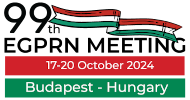A comparative Randomized Trial among different types of low and high power laser therapy, associated with steroid or visco-elastic joint injection under ultrasound guidance in the management of knee osteoarthritis in primary care.
Mihai Iacob
Keywords: Knee ultrasonography, knee osteoarthritis, Low-Power-Lasertherapy-LLLT, High-Intensity-Lasertherapy (HILT), Steroid Joint Injection(SJI), Hialuronic acid joint injection(HAI), knee pain management, Knee POCUS Applications.
Background:
Knee osteoarthritis is a degenerative arthropathy, progressive, disabling, affecting elders, characterized by joint stiffness and pain and structural changes with degradation of joint cartilage, bone remodeling, and inflammatory changes.
This study aims to present the results of Low-Power-Lasertherapy-LLLT, associated with local steroid infiltration, compared with the results after treatment with High-Intensity-Lasertherapy-HILT in infrared emission followed by hyaluronic acid injection with ultrasound guidance.
Research questions:
Which type of therapy is more effective in knee osteoarthritis management?
Method:
Inclusion criteria were patients with moderate or severe knee osteoarthritis in different stages. We conducted a prospective unblinded trial(RCT) over three years, on 750 patients, using two laser devices (semiconductor source). The steroid used in Joint Injections(SJI) was Dexamethasone. We used knee-ultrasonography for diagnostic and therapeutic purposes in all cases. The cases studied were divided into three groups: First, the Control Group included patients without medication, the second included patients treated with LLLT with SJI, and the third group included patients treated with HILT followed by joint-injection of the hyaluronic acid(HAI). Elements evaluated by each patient were: pain on a visual analog scale(VAS), a motion-functional-scale(MFS) of the knee disability, and the WOMAC-Score.
Results:
Our healing rate was only 10% in the first, 77% in the second, and 88%in the third group with significant pain reduction.
Analysis of risk and data obtained on patients by VAS/WOMAC/MFS-scales, before and after treatment, within each group was compared by
Student's t-test, and among all three groups after the final evaluation of patients by ANOVA,p<0,001. The results of 2x2 Contingency-Tabel were: Relative-Risk(RR):0,46 (Benefit), Odds Ratio(OR):0,30-between LLLT/SJI versus Control Group and RR between HILT/HAI was 0,20, 95%CI=0,13-0,29, Odds Ratio=0,11,p<0,0001.
Conclusions:
The combination of HILT and HAI significantly improved the outcome by 48% compared to conventional therapy and may be considered the most effective treatment. HILT followed by a joint-visco-elastic-injection was more effective than LLLT with SJI in knee-osteoarthritis management.
Points for discussion:
What is the contribution of laser therapy to knee osteoarthritis beside SJI or Hyaluronic acid injection?
Can family physicians use laser therapy and knee ultrasonography for diagnostic and therapeutic purposes in their practice?
What are the risks of the Laser-therapy vs SJI vs HAI and what contraindications exist?
#79

